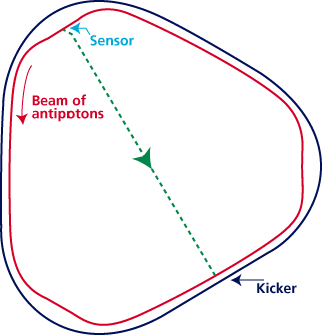![]()
 |
BEAM COOLING |
|
LEILA BELKORA. Cooling:it's a tall glass of iced tea, a plunge in the pool, a blast from the air conditioner. It's also a tool to keep high-energy particles in line. At Fermilab we cool antiprotons, the antimatter counterparts of protons. The problem with freshly made antiprotons is they're like popcorn popping on the stove: because they're "hot,"or have a lot of energy, the antiprotons have a tendency, like the kernels, to zip off in all directions. This tendency works against experimenters, who want particles to travel in orderly beams, like cars on an expressway. Particle physicists have found two methods of keeping antiprotons under control: stochastic cooling or electron cooling. The Antiproton Source at Fermilab uses stochastic cooling to keep antiprotons in line. In the beamline where antiprotons circulate, a sensor measures how fast the unruliest particles in a bunch of antiprotons are moving. A bunch, as a whole, travels at nearly the speed of light; the zippiest particles of any bunch, however, are also bouncing around from side to side and back and forth, in addition to their headlong dash around the tunnel. Once the sensor has recorded how far these extreme particles stray from their desired positions, a signal cuts across the curved path of the beamline. By taking a straight-line shortcut from one side of the circle to the other, the signal can "head them off at the pass" even though the antiprotons move at nearly the speed of light. At the point where the signal meets the beam, the antiprotons receive a corrective "kick" to reduce their side-to-side motion. Simon van der Meer won the Nobel Prize in 1984 for his discovery of stochastic cooling. Unlike stochastic cooling, electron cooling uses no such tricks. As Fermilab engineer Ralph Pasquinelli puts it, the basis of electron cooling is "just like hot and cold running water. If you mix the two, you get lukewarm." Relatively cool electrons mix-temporarily-with hot antiprotons. The two species of particle interact, and antiprotons give up some of their energy to the electrons. Scientists at Novosibirsk in the former Soviet Union pioneered the technique of electron cooling in the 1970s. Fermilab physicists experimented with it in the mid-1980s and are hoping to adapt the technique for use with higher-energy beams in the future. |
